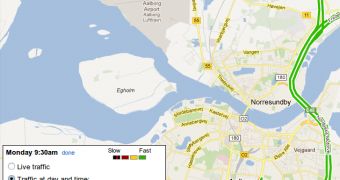Last week, Google brought back traveling time estimates based on live traffic. Now it's adding more traffic-related features with typical traffic data for smaller roads, such as arterial roads, and not just for highways as before.
What this means is that you'll be able to get an estimate of what the typical traffic looks like at a certain time of the day, any day of the week, on the important smaller roads linking the major ones in a city and surrounding area.
Note that this new traffic data is not live, it's based on past data and only estimates the conditions. For example, if traffic is horrible on a Friday night typically, that's what the feature will report even if the actual traffic that particular Friday night may be light.
"If you’re planning a trip for which you anticipate traffic, you can find out what typical traffic is like on these arterial roads, rather than just on highways," Google announced.
As you'd expect, the new data still only covers major cities so you'll still only get highway traffic data in most places. Still, it's a step in the right direction and it does mean that more data will be available to more people.
"Simply type in your starting and ending points to get directions in Google Maps, enable the traffic layer on the upper right hand side of the viewport, and then click 'change' in the legend to switch from live traffic to Typical Traffic for these roads," Google explained.
"You can now access this data for important arterials in cities around the world to help you get where you want to go, and on time," it added.
Google relies on data received from Android phones to gather traffic information. But users have to have the GPS on, a data connection, Google Maps and to opt into the My Location feature for this to work.
As you can imagine, not that many people do, which is why live traffic is less accurate on its own. But, over time, even small amounts of data can be used to predict traffic conditions. For live traffic, Google uses other sources of data as well.

 14 DAY TRIAL //
14 DAY TRIAL //